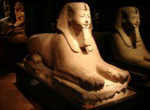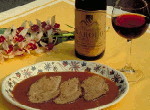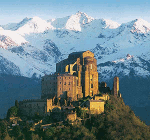Two thousand years of engrossing history have left, for the benefit of the passionate or just curious tourist, countless works of art, which today we can admire in beautiful sceneries in the open air or in the rich collections of the many museums.

A classical starting point is the high building symbolizing Turin, the Mole Antonelliana, a daring architectural masterpiece inaugurated in 1889, at that time the tallest building in Europe made entirely in bricks. Also built at the end of the Nineteenth century but recalling atmospheres of older times, the picturesque Medieval Village will charm you, mirroring on the placid waters of the river Po in the Valentino Park, ideal place for relaxing walks among lush gardens and in the shadow of old trees.
As the protagonist of the history of Turin for nearly a millennium, the Savoy dynasty, among the most durable ruling families in the world, has not only been at the centre of the political and military events that culminated in the unification of Italy, but was also the promoter of a refined taste for art and culture. It is to this dinasty that we owe many of the treasures that Turin can show today.

Let's start with the "Crown of Delights", theatre of life and power of the Savoy House, a set of royal residences that embrace the city and form a unicum in Europe, recognized as a World Heritage Site by UNESCO in 1997: Royal Palace, Madama Palace, Carignano Palace, Valentino Castle, Queen's Villa, Royal Palace in Venaria Reale, Hunting Lodge in Stupinigi, Moncalieri Castle, Rivoli Castle, Castle Village in La Mandria park, as well as other castles and residences around Turin. And let's continue with many rich museums: Civic Museum of Ancient Art in Madama Palace, Royal Armoury in the Royal Palace, Savoy Gallery, a prestigious collection of Italian and Flemish paintings, National Museum of the Italian Risorgimento in Carignano Palace.

And how not to mention those museums, witnesses of the past and tradition but also of progress and "know-how" of the city, unmatched in Italy and at top level in the world? Egyptian Museum, the oldest in the world and still today the second most important after the Cairo one, National Museum of Cinema, in the spectacular scenery inside the Mole Antonelliana (the "seventh art" in Italy was born right in Turin at the beginning of the Twentieth century), MAUTO-National Automobile Museum, real witness of the industrial vocation of the city described through the history of the motor-car and the social behaviours associated with it, MAO-Oriental Art Museum, which holds one of the most prestigious collections of Asian art in Italy and in Europe, National Museum of the Mountains, from whose terrace we can enjoy a great view over the city as far as the Alps.

For fans of today's and tomorrow's art, but also for those who wish to approach as simply curious people to new artistic international languages, Turin offers GAM-Gallery of Modern and Contemporary Art, Sandretto Re Rebaudengo Foundation, Merz Foundation, Giovanni and Marella Agnelli Painting Gallery, Museum of Contemporary Art at Rivoli Castle. But it will be amazing also to discover the contemporary face of the city just on a bus tour or walking, as in an open-air museum with works by internationally renowned artists and futuristic urban architectures: the central "Spina" ("backbone"), new urban areas resulting from the underground laying of the railway and the conversion of old industrial complexes, Igloo by Mario Merz, Arte Povera by Giuseppe Penone, Intesa-Sanpaolo's skyscraper designed by Renzo Piano, Lingotto, a former FIAT car factory converted by Renzo Piano in a magnificent multifunctional complex, the impressive Olympic Arch ... and much more, in ever-changing spaces!
Turin is a hospitable city: the reception sensitivity has its roots in the Middle Ages, when the city was a stopover for pilgrims along the via Francigena, which, from the Alpine passes such as Montgenevre, Mont Cenis and Great St. Bernard, led to Rome and Jerusalem.

Religion and spirituality can be strongly perceived still today, thanks to the many religious buildings scattered throughout the city and its province: the Renaissance Cathedral of San Giovanni, which preserves the Holy Shroud, the sacred linen cloth that, according to the Christian tradition, wrapped Christ's corpse in the Holy Sepulchre; authentic jewels of baroque architecture, such as the church of San Lorenzo, with the amazing dome by Guarini, the "twin" churches of San Carlo and Santa Cristina in Piazza San Carlo, the church of Corpus Domini consecrated to the miracle of the Blessed Sacrament occurred in 1453; the sanctuary of Consolata which, together with the neo-classical basilica of Maria Ausiliatrice founded by Don Bosco, is the protagonist of people's devotion; the church of San Filippo Neri, the largest religious building in the city; the temple of Gran Madre di Dio, that watches imposing and mysterious over the wide Piazza Vittorio Veneto that faces it on the opposite bank of the river Po. In the middle of an area affected by a futuristic program of urban renewal, the modern and original church of Santo Volto has been built, a "mechanic flower" evocative of the former industrial use of that area, according to the definition given by Mario Botta, the Swiss architect who designed it. On top of one of the hills overlooking the city stands one of the masterpieces by Juvarra, the basilica of Superga, whose underground crypts house the monumental tombs of the Savoy kings.
The spiritual vocation of Turin and its whole region is not only made of places but also - and above all - of people. The acts of charity and assistance done by the Social Saints in the Nineteenth century have left memories and events that have marked the history of the population in Turin and the whole Catholic Church: the saints Giovanni Bosco, Giuseppe Benedetto Cottolengo, Giuseppe Cafasso, Leonardo Murialdo and the blessed Francesco Faa di Bruno, Pier Giorgio Frassati, Giuseppe Allamano and Giulia Falletti di Barolo.

For those who love to dream up, Turin offers countless mystical fascinations: "magic city", "city of mysteries", "devil's city" are some of the definitions that have been associated with Turin. Although they are fantasies and legends, there is always some truth behind the rumors: a tradition, a historical event, a literary narrative, a misunderstanding, a coincidence. And how many characters, so different from one another, have stayed in Turin: Nostradamus, Erasmus of Rotterdam, Casanova, Mozart, Rousseau, Nietzsche, the Holy Inquisition, the Freemasonry and, around Turin, even the Templars!

A visit to Turin, in order to be complete and satisfying, cannot be limited to important works of art but must also extend to the pleasures of good food, based on a long and genuine tradition: appetizers to accompany the famous Turinese grissini (breadsticks), first courses with excellent pasta such as agnolotti and tajarin, original second courses, such as the fritto misto, an incredible cohesion of sweet and savory ingredients, the bagna cauda, in which you can dip different types of raw vegetables, the bollito misto, accompanied by delicious sauces such as the bagnet verd; the wide variety of meats and cheese of genuine production and high quality, from the Alpine valleys of our province. All this cuisine, of course, will be accompanied by excellent red and white wines from our province.

While taking a walk under the elegant arcades of the city centre you will certainly be attracted by the windows of pastry shops and historical cafés, with their chocolates including the original gianduiotti and soft cream chocolates, cakes, cream puffs and the unmissable hot drinks such as bicerin, zabaione (eggnog) and hot chocolate (the first cocoa beans were brought to Piedmont even in the mid Sixteenth century by Emanuele Filiberto of Savoy!). Moreover, for a refreshing pleasure you can enjoy a delicious and high quality homemade ice cream, including the famous Penguin, the first chocolate-coated ice cream on a stick in the world, created in Turin in 1937.
Finally, to put a right end to a pleasant afternoon walk and foretaste the real dinner, you cannot give up the ritual of an aperitif, with a cocktail made with vermouth, invented in Turin at the end of the Eighteenth century by Antonio Benedetto Carpano and very popular all over the world still today.

Small art towns, pleasant hills, crystal clear lakes, the crown of the Alps, green valleys, ancient traditions: the province of Turin offers extraordinary experiences, with superb evidences of past times, the pleasure of good food and the taste of great wines thanks to unique gastronomical traditions.

A few miles away from Turin you will find a vast and varied heritage of art and culture, made of natural parks, ancient towns, archaeological sites, abbeys, sanctuaries, castles, aristocratic mansions, eco-museums, forts, military or pilgrimage roads: everything can be easily reached along scenic routes or immersed in nature, in a region characterized by different landscapes, from plains to hills, up to magnificent mountain sceneries.
Rediscover the atmosphere of bygone days and the flavour of ancient traditions with enchanting one-day excursions. Here are just a few of the many opportunities:
Are we missing something? Almost certainly ... since the treasures are so many and sometimes hidden! But spotting them along the way, during an excursion through beautiful landscapes, will be an unforgettable surprise!